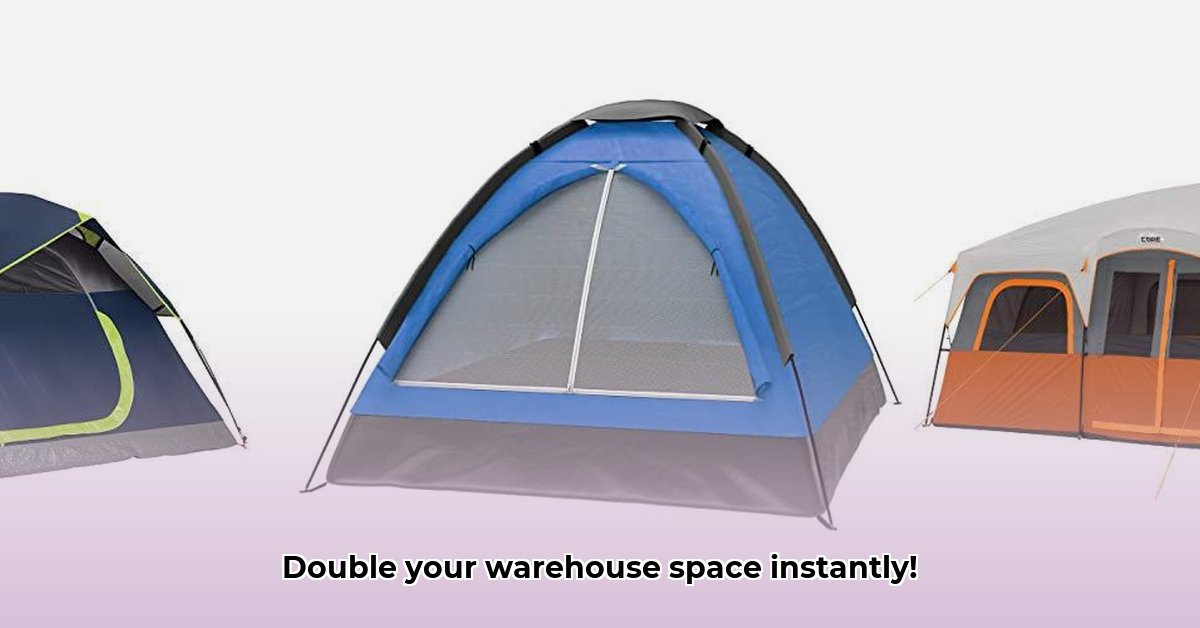Feeling cramped in your warehouse? Outgrowing your space doesn’t have to be a headache. Lightweight mezzanine floors offer a smart, affordable way to dramatically increase your storage area. This guide walks you through selecting and installing a mezzanine system that boosts efficiency for years. We’ll explore different types, compare materials (cold-formed vs. regular steel), and show you how to choose the best design. This guide is for warehouse managers, building owners, and engineers seeking practical solutions for space optimization. For more information on freestanding options, check out this resource.
Lightweight Mezzanine Floor Solutions: A Practical Guide to Optimized Storage and Space Planning
Need more warehouse space? Lightweight mezzanine floors increase storage capacity without huge construction projects. This guide helps you understand options and choose the right solution, focusing on efficient space planning and warehouse optimization while avoiding common storage solutions pitfalls.
Choosing the Right Material: Steel’s Two Sides for Mezzanine Structures
Steel is the most common material for lightweight mezzanines, yet traditional and cold-formed steel offer distinct advantages. Traditional steel provides exceptional strength for heavy loads. Cold-formed steel balances strength and weight, making it lighter, easier to work with, and often more economical. Understanding the nuances of steel grades is critical for structural integrity.
| Feature | Traditional Steel | Cold-Formed Steel |
|---|---|---|
| Strength | Exceptional; ideal for very heavy loads | Very strong; suitable for most warehouse uses |
| Weight | Heavier, requiring stronger supporting structures | Significantly lighter; easier on building supports |
| Installation | More complex; often requires specialized crews | Generally faster and simpler; potentially DIY-friendly for smaller structures |
| Cost | Typically higher initial investment | Often lower upfront cost, potentially saving money |
| Lifespan | Very Long, with proper maintenance | Long, but may need more frequent inspections |
The best material depends on your warehouse’s specific needs and weight requirements, aligning with your budget allocation. Consider factors like seismic activity in your region, as cold-formed steel may offer advantages in earthquake-prone areas due to its flexibility.
Design Decisions: Inset vs. Oversail Mezzanines for Enhanced Headroom
Considering structural design considerations is paramount. Inset and oversail are two common configurations in mezzanine construction. An inset mezzanine, built inside existing building supports, maximizes usable ceiling height below, providing optimal headroom clearance. An oversail mezzanine extends beyond building columns, offering more storage space, though potentially reducing headroom. The choice hinges on warehouse layout and operational priorities; understanding your vertical space is essential. Think about the equipment that needs to operate beneath the mezzanine. Will forklifts need to navigate the space? This could influence your decision on headroom and support column placement.
Modular or Custom: Building Your Perfect Mezzanine with Flexible Options
Next up: modular versus custom designs, impacting construction costs and installation time. Modular systems feature pre-fabricated sections for quick assembly and future modifications, offering flexible expansion capabilities. Custom-designed mezzanines, tailored precisely to building dimensions, maximize space efficiency but require longer design and installation times. Modular mezzanines often provide tax advantages due to their classification as equipment rather than permanent structures, potentially offering accelerated depreciation.
Key Factors to Consider Before You Buy a Mezzanine System
Before purchasing, consider these crucial factors:
- Load Capacity: Determine the required load-bearing capacity based on intended use, ensuring structural safety. Consider dynamic loads (moving equipment) and static loads (stored goods).
- Headroom Clearance: Ensure adequate vertical space for equipment and personnel, factoring in ergonomic design. Remember to account for lighting fixtures and sprinkler systems when calculating headroom.
- Building Codes and Regulations: Comply with local/national building and safety codes (ANSI, AISC, IBC), seeking professional consultation. Engage a qualified engineer to ensure your design meets all relevant codes.
- Budget: Compare costs for each option, factoring in installation, materials, and maintenance, optimizing cost efficiency. Include potential costs for permits, inspections, and fire suppression systems in your budget.
- Installation Process: Choose systems based on complexity, expertise required, and potential project management needs. Factor in potential downtime during installation and strategies to minimize disruption to warehouse operations.
- Fire Safety: Integrate fire-resistant materials, sprinkler systems, and clearly marked exits to ensure employee safety.
A Step-by-Step Guide to Choosing Your Mezzanine for Optimized Workflow
- Assess Your Storage Needs: Determine space requirements and goods types, influencing load capacity, optimizing warehouse flow. Analyze inventory turnover rates to determine the optimal storage configuration.
- Consult Professionals: Seek advice from structural engineers for building suitability, and consult mezzanine installation contractors regarding project feasibility. Obtain multiple bids from reputable contractors and verify their insurance and licensing.
- Compare Quotes and Options: Get quotes from multiple suppliers, comparing prices, materials, and warranties, focusing on value engineering. Explore different financing options, including leasing and purchasing, to determine the most cost-effective solution for your business.
- Obtain Necessary Permits: Secure required permits and approvals before installation to prevent delays, ensuring regulatory compliance. Be prepared to provide detailed drawings, specifications, and calculations to the permitting authority.
- Oversee Installation: Monitor installation to ensure correct execution and specification adherence, employing quality control. Conduct regular site meetings with the contractor to address any issues or concerns.
- Final Inspection: Schedule a final inspection to verify functionality and code compliance, guaranteeing long-term operational safety. Obtain a certificate of occupancy from the local building department after the final inspection.
Investing in a lightweight mezzanine floor solution, when planned properly, increases storage capacity and optimizes warehouse space. Consulting professionals throughout the process ensures success.
How to Compare Long-Term Costs of Different Mezzanine Warehouse Systems for Cost-Effective Operations
Key Takeaways:
- Mezzanine floors boost warehouse space, efficiency, and lower long-term costs with careful planning, focusing on return on investment (ROI).
- Material selection, design (inset vs. oversail), and modularity impact initial and long-term costs, essential for budget planning.
- Consider load capacity, headroom, building codes, and maintenance for a comprehensive cost-benefit analysis, focusing on lifecycle assessment.
- Consult engineers/contractors for optimal design, installation, and long-term performance, ensuring quality assurance.
Understanding Your Mezzanine Needs for Warehouse Optimization
Before cost comparisons, clarify warehouse footprint, intended use, and weight capacity, influencing material selection and overall cost, essential for facilities management. Consider the impact of the mezzanine on existing HVAC, lighting, and fire suppression systems.
Types of Lightweight Mezzanine Systems: A Comparative Look for Informed Decisions
Choosing involves more than just upfront costs. How to compare long-term costs of different mezzanine warehouse systems involves considering these factors:
| Feature | Cold-Formed Steel | Traditional Steel |
|---|---|---|
| Initial Cost | Lower | Higher |
| Strength | High for its weight; suitable for lighter loads | Excellent strength; ideal for heavy loads |
| Lifespan | Generally shorter | Generally longer |
| Installation | Often faster and easier | Can be more complex and time-consuming |
| Maintenance | Lower | Potentially higher |
| Fire Resistance | Requires additional fireproofing | Naturally more fire-resistant |
Design (inset vs. oversail) affects access and structural support. Modular vs. Custom impacts installation speed and flexibility, both involving warehouse management considerations. Consider the long-term flexibility of each system. Can a modular system be easily reconfigured to meet changing needs?
Factors Influencing Long-Term Costs of Mezzanine Systems for Sustainable Solutions
Load capacity and headroom impact design choices and construction costs. Building code adherence (ANSI, AISC) is mandatory. Installation complexity varies depending on system design. Regular maintenance prevents costly repairs. Energy efficiency is an often-overlooked factor. Consider the impact of the mezzanine on lighting and HVAC costs.
Step-by-Step Guide to Selecting Your System for Optimal Warehouse Design
- Assess your needs: Define intended use, weight capacity, and headroom requirements, focusing on space utilization. Conduct a thorough inventory analysis to determine the optimal storage layout and capacity.
- Get professional advice: Consult structural engineers and experienced contractors, employing knowledge management. Engage a fire protection engineer to ensure the mezzanine meets all fire safety requirements.
- Obtain multiple quotes: Compare costs, ensuring specifications are met, focusing on supplier selection. Request detailed breakdowns of all costs, including materials, labor, permits, and inspections.
- Review the contracts: Pay attention to warranties, payment terms, and liability, employing risk management. Have a lawyer review the contract to ensure your interests are protected.
- Secure necessary permits: Begin early to avoid timeline impacts, focusing on compliance management. Be prepared to provide detailed documentation and address any questions or concerns from the permitting authority.
- Monitor installation: Check progress and address concerns promptly, ensuring project oversight. Conduct regular site visits to monitor progress and ensure the work is being performed according to the contract.
[This guide offers a starting point for evaluating mezzanine system costs. Thorough planning and consultation are crucial for
- Kitchen Island Plans: Build Your Dream Centerpiece At Home - October 24, 2025
- Kitchen Island Blueprints: Free Plans For Your Dream Space - October 23, 2025
- Kitchen Island Base Without Top: Perfect Custom Counter? - October 22, 2025










